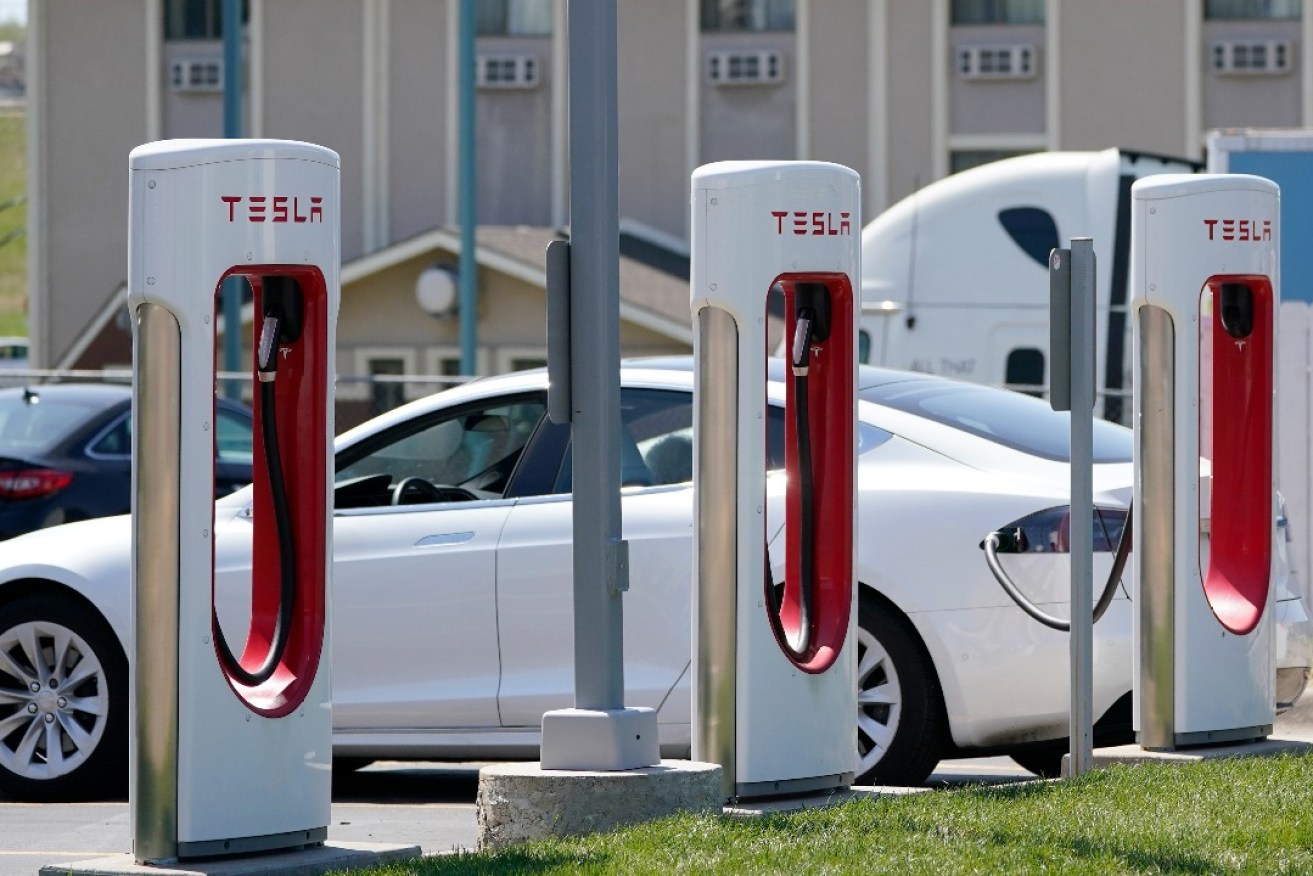Lord Mayor fires up over ‘hideous’ EV chargers
Adelaide Lord Mayor Jane Lomax-Smith says it would be an “abomination” to put electric vehicle chargers on “aesthetic” residential streets, amid a city council debate about where to locate charging infrastructure.


A row of Tesla chargers at a station in Topeka, Kansas. Photo: Orlin Wagner/AP
Councillors on Tuesday discussed a report outlining what role Adelaide City Council should play in installing electric vehicle (EV) charging infrastructure across the city.
The report, compiled by engineering and sustainability consultants ARUP, forecasts between 6500 and 19,500 EVs will travel through the city and North Adelaide by 2033.
ARUP identified O’Connell Street and Melbourne Street in North Adelaide as priority locations for on-street charging.
The consultants also recommended on-street charging around Sturt Street, Hutt Street, Carrington Street, Victoria Drive and Beaumont Avenue.

A map of priority locations for EV chargers in the city and North Adelaide. Image: ARUP
But Lomax-Smith said on-street charging on aesthetic residential streets should be avoided at all costs.
“I think this is a great document, but it does raise a few problems for people who live in the city,” she told councillors.
“I love the line (in the report) that ‘on street charging risks negatively impacting residential amenity’ – my point precisely: these are hideous.
“I do not support any of these on residential streets.
“It’s fine to be on an open lot car park… but to have this on an aesthetic street is an abomination – we can’t do this.”
South Ward councillor Mark Siebentritt, who asked for the report in March, said he estimated 650 to 1950 EV chargers would be needed to accommodate expected demand.
There are currently 137 public EV chargers – council and non-council owned – across the City of Adelaide, according to the report.

A charging hub in Lovosice, Czech Republic. Photo: Ondrej Hajek/CTK via AP Images
The council’s 2022-25 Climate Action Plan set a goal to install an additional 100 EV chargers.
A majority of city council-owned EV chargers are located off-street, with 79 per cent of the council’s 54 EV chargers in UPark facilities, according to the report.
The report says off-street charging is “preferable” to on-street charging and the latter should be “carefully applied only where truly needed”.
It also identifies UParks in Topham Mall, Light Square, Rundle Street and the Central Markets as priority locations for more chargers.
The report recommends that council “considers the provision of on-street charging only where no off-street alternative is available and plays a coordination role in controlling urban realm outcomes to avoid oversupply in residential areas”.
Amendments to the National Construction Code in October 2024 will also require all car parking spaces in new apartment buildings to have EV charging.
“However, the above standards only apply to new builds,” the ARUP report notes.
“There are a large amount of apartment dwellings, or dwellings without off-street parking in the CoA (City of Adelaide) that will require EV charging retrofit or access to a reliable EV charging network.”
The ARUP report also found that factors unique to the city meant demand for charging would outstrip what could be provided in local apartments.
“The CoA has a high population density, particularly those living in apartments, compared to other parts of the metropolitan area – as well as high job density,” the report said.
“Both of these factors create demand for EV charging beyond what can be provided in private residences – which will require on-street and off-street charging solutions.”
Deputy Lord Mayor Phillip Martin questioned the report’s recommendation that council play a partner, rather than lead, role in installing EV charging infrastructure.
He suggested there should be a discussion about “the potential for the city to derive substantial revenue in five, 10, 15 years in the same way… that the councils of the 1980s saw that car parks would be an absolute money spinner in the 2000s”.
ARUP senior planner Daniel Conley said it would require the council to find “more staff, more capacity building (and) new teams that are built around doing that”.
“If that’s a direction that council wants to go in almost operating that business then that’s council’s decision,” he said.
“I think we saw more of that in the early stages of the EV transition when there was more of a role for government to stimulate the initial charging points for the early adopters.
“But it certainly seems to be the case across the board at the moment across Australia and even Asia that the private sector is just delivering these solutions much more efficiently and they take responsibility for the maintenance and the replacement.”
Renting out charging space in public streets and parking spaces could still provide a revenue source for council, Conley said.
“Particularly in the CBD, if that commercial model is going to work for any local government it’ll be the City of Adelaide because there’s that level of demand there,” he said.




